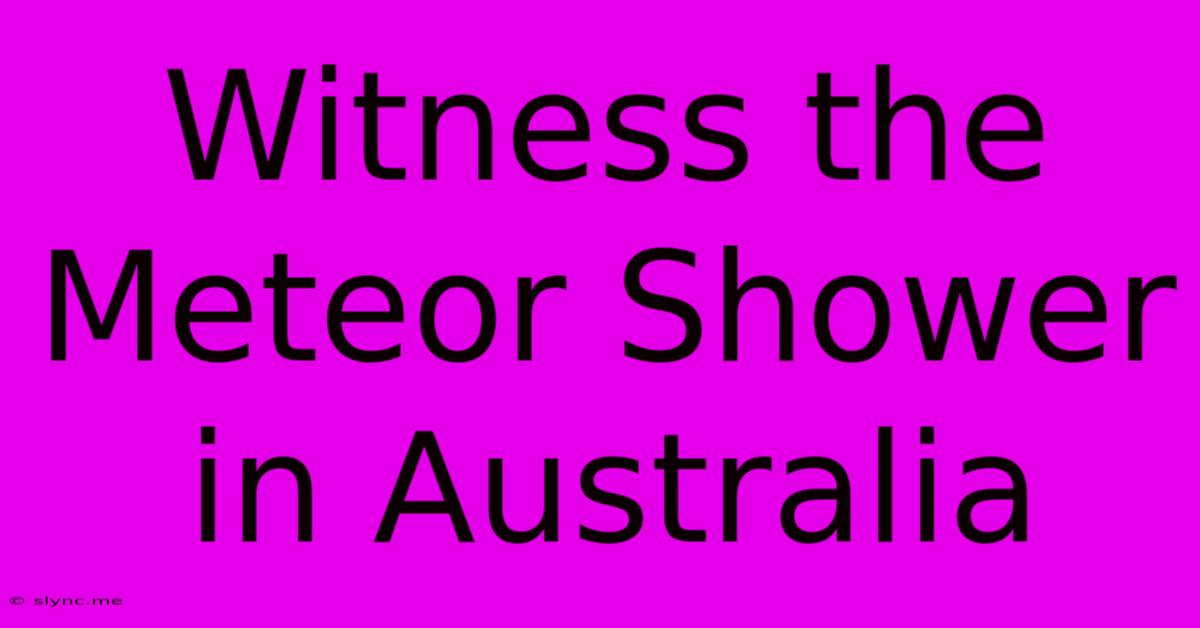Witness The Meteor Shower In Australia

Discover more detailed and exciting information on our website. Click the link below to start your adventure: Visit Best Website Mrs.Amykhan. Don't miss out!
Table of Contents
Witness the Meteor Shower in Australia: A Stargazer's Guide
Australia, with its vast, sparsely populated landscapes and minimal light pollution, offers unparalleled opportunities for celestial observation. Witnessing a meteor shower here is a truly unforgettable experience. This guide will help you plan your own magical night under the Australian stars.
Best Times and Locations for Meteor Shower Viewing in Australia
The best time to see a meteor shower depends on the specific shower. Major annual showers visible from Australia include:
- Eta Aquarids (May): This shower often produces bright meteors, best viewed in the pre-dawn hours.
- Orionids (October): Another strong shower, visible throughout the night.
- Geminids (December): Often considered one of the year's best, with numerous bright meteors.
- Quadrantids (January): This shower can produce high rates of meteors, but its peak is short.
To maximize your chances of witnessing a spectacular display, consider these factors when choosing a viewing location:
- Dark Skies: Escape the city lights! Head to national parks, outback areas, or remote beaches far from urban centers. Light pollution drastically reduces visibility. Websites and apps like Dark Site Finder can help you locate dark sky areas.
- Clear Weather: Check the weather forecast before you go. Cloudy skies will completely obscure the meteor shower.
- Open Horizon: Choose a location with an unobstructed view of the sky, preferably with a wide-open horizon. Mountains or tall buildings can block your view.
- Comfort: Remember you'll be outside for a while, so dress warmly, bring a comfortable chair or blanket, and maybe even a thermos of hot chocolate.
Top Spots for Meteor Shower Viewing Across Australia
Australia boasts many incredible locations ideal for stargazing. Here are a few suggestions:
- Warrumbungle National Park (NSW): This park is renowned for its dark skies and has been designated an International Dark Sky Park.
- Uluru-Kata Tjuta National Park (NT): Witnessing a meteor shower with Uluru in the foreground is an unforgettable experience.
- Lake Tyrrell (Victoria): This salt lake creates stunning reflections of the night sky, enhancing the meteor shower experience.
- Nullarbor Plain (SA): This vast, flat plain offers expansive views of the night sky with minimal light pollution.
- Tasmania's West Coast: The remote west coast of Tasmania provides some of Australia's darkest skies.
Tips for Maximizing Your Meteor Shower Experience
- Give your eyes time to adjust: It takes around 20-30 minutes for your eyes to fully adapt to the darkness. Avoid looking at bright lights during this time.
- Bring binoculars or a telescope (optional): While you can see meteors with the naked eye, binoculars or a telescope can enhance the experience by allowing you to see fainter objects.
- Be patient: Meteor showers aren't continuous displays. There will be periods of inactivity, so be patient and enjoy the quiet beauty of the night sky.
- Learn about the shower: Familiarize yourself with the radiant point of the meteor shower (the point in the sky from which the meteors appear to originate). This will help you focus your attention.
- Check for any moon interference: A bright full moon can wash out fainter meteors, reducing the visibility of the shower.
Capture the Magic: Photography Tips
For those wanting to capture the stunning spectacle, consider these photography tips:
- Use a wide-angle lens: This will allow you to capture a larger portion of the sky.
- Set a long exposure: A longer exposure time will allow you to capture more meteors. Use a tripod for stability.
- Shoot in RAW format: This will give you greater flexibility for editing your photos later.
- Experiment with settings: Adjust your ISO, aperture, and shutter speed to find the best settings for your camera and conditions.
Witnessing a meteor shower in Australia is a truly awe-inspiring experience. By following these tips and choosing a suitable location, you can create unforgettable memories under the spectacular Australian night sky. Remember to respect the environment and leave no trace behind. Happy stargazing!

Thank you for visiting our website wich cover about Witness The Meteor Shower In Australia. We hope the information provided has been useful to you. Feel free to contact us if you have any questions or need further assistance. See you next time and dont miss to bookmark.
Also read the following articles
| Article Title | Date |
|---|---|
| Shou Konkurentiv Mudrika Astana Chelsi Video | Dec 13, 2024 |
| The Game Awards 2024 Astro Bot Ta Inshi Nagorodi | Dec 13, 2024 |
| Rozrobnik Mikhaylo Shatskiy Smert I Pam Yat | Dec 13, 2024 |
| Vistup Trubina Videoobzor Matchu L Ch | Dec 13, 2024 |
| Zvyagel Vidznachaye Den Sukhoputnikh Viysk | Dec 13, 2024 |
